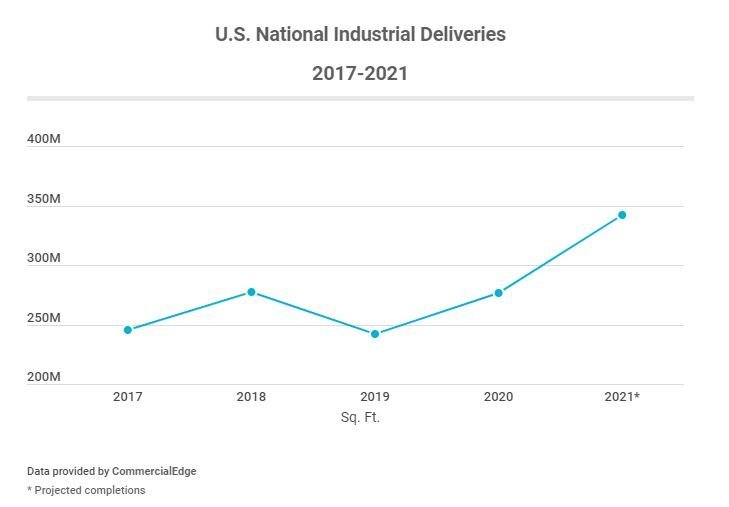This post originally appeared on tBL member SCGWest’s blog and is republished with permission. Find out how to syndicate your content with theBrokerList.
As high density cities continue to become more expensive to live in, tenants and landlords are looking for places that offer more land at more competitive rates. Popular on this list of locations are Texas, Florida, and Arizona. Azbigmedia reports that this trend is becoming common for aging millennials, as they are starting to develop families that demand more real estate. This trend is also affecting large companies including Hewlett Packard, CBRE, and Oracle which are all moving their headquarters to Texas.
With the rise of online shopping and increased need for distribution centers, studies are showing that industrial property construction is booming. By now, people have gotten used to ordering things online more than ever and the market is responding. But demand from online shopping is not the only factor that is making industrial construction so prominent right now. Investors see investing in industrial properties as more of a safe bet in these uncertain times as historically, industrial real estate is seen as more of a stable investment. An article from Commercial Search explains that industrial property construction is going to hit a 5-year high. In last year alone, 276 million square feet in 915 properties was developed into industrial property. The states at the top of this list were Dallas and Phoenix, which have more land to offer at more competitive prices. Unsurprisingly, Amazon is set to occupy the largest industrial completions in 2021. In fact, Amazon makes up 8 out of the top 10 of them. This trend does not seem to be going away anytime soon.
As stimulus checks and COVID related small business relief have been handed out over the past year, some have begun to worry about inflation. On a positive note, it appears as though even if inflation is to come, it has not had a negative impact yet. From an article from Globe St., Cushman & Wakefield reports that headline cap rates have remained about the same since late 2019, a surprising sign of stability during this time of uncertainty. Although this report rules out inflation as an immediate problem, as mentioned in last month’s update, there is still the fact that construction costs are still rising, making owners spend substantially more on buildouts than what was usual in the past.
The fact that restaurants were hit hard last year is a point you have undoubtedly heard before, but nonetheless, it’s a point that bears repeating. It’s difficult to overstate the challenges that restaurant owners have been through last year. A report from Plutos Sama Holdings indicates that “2020 more than 110,000 restaurants in the U.S. were forced to temporarily or permanently close, and total sales across the restaurant industry in 2020 were a staggering $240 billion below pre-pandemic forecasts”. The National Restaurant Association reports that restaurant jobs are still at a level that is lower than they were at the beginning of 2020 confirming that the industry is still in recovery despite making some definite strides since the initial pandemic hit.

Despite this news, Plutos Sama Holdings predicts that “we are on the cusp of a critical inflection point” as they expect well capitalized investors to invest heavily in restaurants now while prices and interest rates are low in order to generate ROI in 2023-2025. In addition to this, the Federal Reserve has confirmed that interests rates are set to remain low for the near future, giving commercial real estate investors the ability to more easily get financing for their investments. On last Wednesday, Jerome Powell, chairman of the Fed explained that the low interest rates are meant to aid in the economies recovery which he described as “uneven and far from complete”. Now that there is a massive surge in demand, vaccines are widely available, and people are becoming more comfortable with eating at restaurants, the economy is expected to make a comeback and investors are betting on it.
One trend that restaurant owners should pay attention to is the addition of different types of contact-limiting packaging. Kristi Kingery, the vice president of supply chain and strategic initiatives for Tropical Smoothie Cafe, mentioned that after March of 2020, the main focus of the packaging industry had shifted away from making packaging environmentally sustainable to instead safety and sanitation. Ashley Elzinga, the Food Service Packaging Institute’s director shared with the National Restaurant Association that COVID has made “tamper resistant packaging” such as adding a sticky seal to plastic take out bags, more prominent than ever. Another addition to this trend is the increasing popularity of drive-thru’s and curbside pickup.

The retail industry is looking more positive to retail land owners. Globe St. reports that in March, retail rent collections arose to be within 4% of pre-pandemic levels. This shows that thankfully, things are generally looking positive for the retail sector. Within the retail sector, some segments are performing better than others. For example, national tenants are doing better than non-national tenants, and clothing and grocery stores are doing better than restaurants and barbershops.
Talks of stimulus checks have typically been seen as optimistic for retail stores. The idea behind this is that with an extra $1400 in their pockets, American citizens will choose to go to the store and splurge. However, new studies are showing that American’s are choosing to save their stimulus checks rather than spend them at stores. A CNN analysis of a New York Federal Reserve survey reports that the average household is saving 42% of the check, paying off debt with 34% of it, and spending only about 25% of it. The study is also finding that with each new stimulus check, Americans are spending less of it and saving more of it. It also finds that when the checks are spent on shopping, they are mostly towards online shopping.

One thing most office workers can relate to during the last year is working at home for at least part of 2020. Many are still working at home still as of now and some companies such as Atlassian, Dropbox, and Facebook have decided to implement working at home indefinitely. Many companies see massive savings on office leases by switching completely to remote work, while others are starting to realize that office spaces allow for more work productivity. Although remote work is convenient, it also contains many more distractions that can tend to hamper productivity. Experts say that different aspects of working from home both help and hurt productivity. A study by E. Glenn Dutcher published by the Journal of Economic Behavior & Organization found that working remotely slows down workers while performing dull tasks, but boosts the productivity when workers are performing creative tasks. Open environments generally allow workers to think more creatively, but offer too many distractions when workers need to perform dull tasks.
Regardless of where you fall in the work from home vs. work in the office debate, fortunately for office space owners, demand for office spaces has risen 161 percent in Q1 of 2021 according to the VTS Office Demand Index (VODI). This puts the level of demand for office spaces within 9% of pre-pandemic levels. Clearly, many companies are itching to get back in offices. Globe St. reports that if this trend continues, office space demand could meet and exceed pre-pandemic levels very soon.




